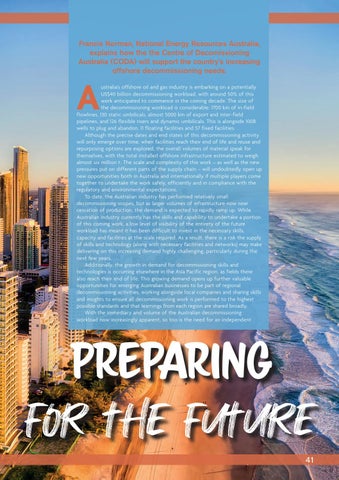Francis Norman, National Energy Resources Australia, explains how the the Centre of Decomissioning Australia (CODA) will support the country’s increasing offshore decommissioning needs.
A
ustralia’s offshore oil and gas industry is embarking on a potentially US$40 billion decommissioning workload, with around 50% of this work anticipated to commence in the coming decade. The size of the decommissioning workload is considerable: 1700 km of in-field flowlines, 130 static umbilicals, almost 5000 km of export and inter-field pipelines, and 126 flexible risers and dynamic umbilicals. This is alongside 1008 wells to plug and abandon, 11 floating facilities and 57 fixed facilities. Although the precise dates and end states of this decommissioning activity will only emerge over time, when facilities reach their end of life and reuse and repurposing options are explored, the overall volumes of material speak for themselves, with the total installed offshore infrastructure estimated to weigh almost six million t. The scale and complexity of this work – as well as the new pressures put on different parts of the supply chain – will undoubtedly open up new opportunities both in Australia and internationally if multiple players come together to undertake the work safely, efficiently and in compliance with the regulatory and environmental expectations. To date, the Australian industry has performed relatively small decommissioning scopes, but as larger volumes of infrastructure now near cessation of production, the demand is expected to rapidly ramp up. While Australian industry currently has the skills and capability to undertake a portion of this coming work, a low level of visibility of the entirety of the future workload has meant it has been difficult to invest in the necessary skills, capacity and facilities at the scale required. As a result, there is a risk the supply of skills and technology (along with necessary facilities and networks) may make delivering on this increasing demand highly challenging, particularly during the next few years. Additionally, the growth in demand for decommissioning skills and technologies is occurring elsewhere in the Asia Pacific region, as fields there also reach their end of life. This growing demand opens up further valuable opportunities for emerging Australian businesses to be part of regional decommissioning activities, working alongside local companies and sharing skills and insights to ensure all decommissioning work is performed to the highest possible standards and that learnings from each region are shared broadly. With the immediacy and volume of the Australian decommissioning workload now increasingly apparent, so too is the need for an independent
41
